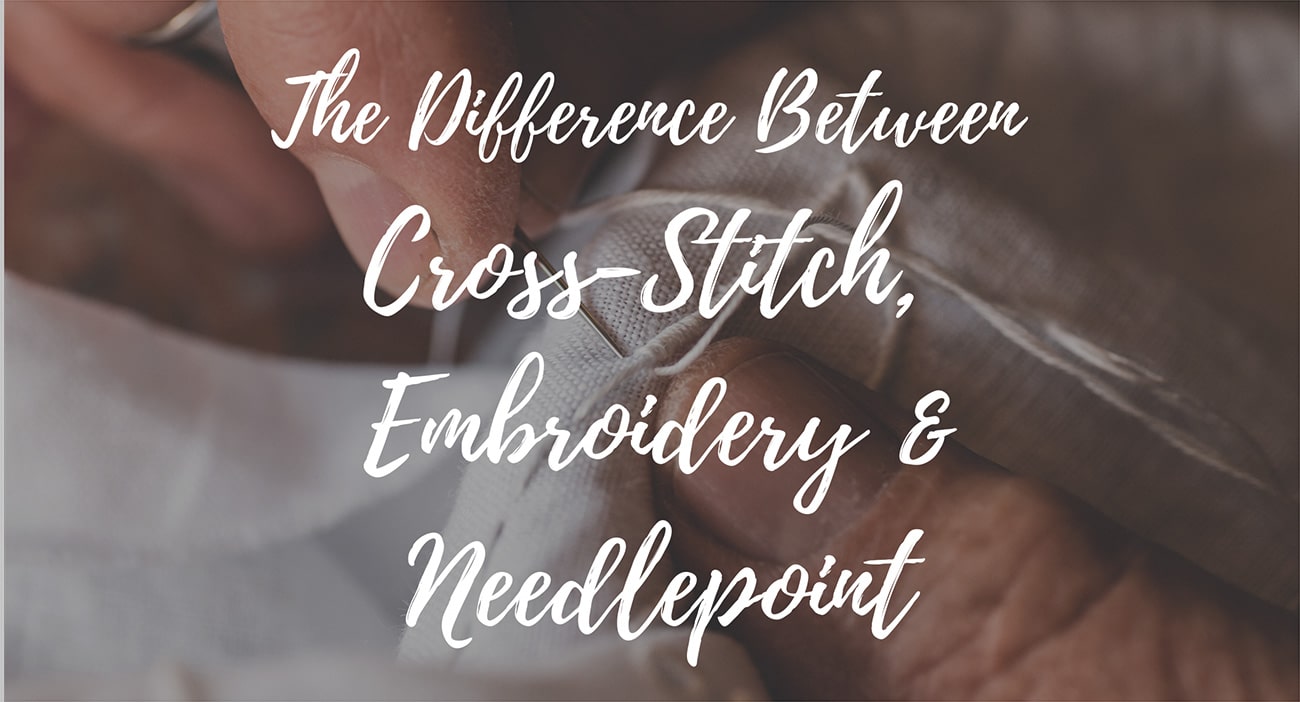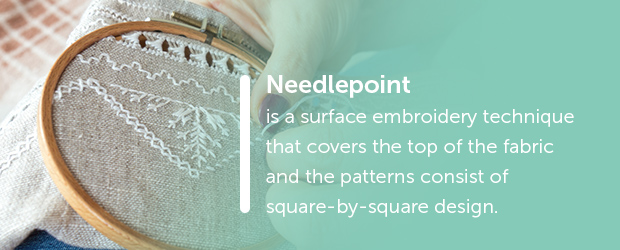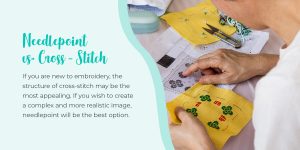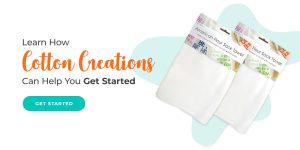
The Difference Between Cross-Stitch, Embroidery and Needlepoint
Table of Contents
- What Are the Different Types of Embroidery?
- Machine Embroidery
- Hand Embroidery
- Cross-Stitch
- Needlepoint
- Which Type of Embroidery Should You Use?
- Needlepoint vs. Cross-Stitch
- Surprising Benefits of Needlepoint, Hand Embroidery and Cross-Stitch
Machine embroidery, hand-embroidery, cross-stitch and needlepoint are all artistic ways of expression, but each form is very different, both in terms of final effects and their materials. Below you will find valuable information on the differences between these crafting methods that hopefully can help you decide which is right for your next project.
What Are the Different Types of Embroidery?
Embroidery is a broad term referring to the art of decorating material with needle and thread. There are both machine-driven embroidery methods as well as hand-driven embroidery methods, and we will explain the pros and cons of each.
Machine Embroidery
Embroidery machines have become important tools in the apparel industry, where they are used to mass-produce complex designs. A design is created using computer software, the software is installed on the machine, and the machine creates the embroidery. Companies who want t-shirts with their logo embroidered on them, for example, will use embroidery machines to mass produce their shirts.

Embroidery machines are not only available for commercial use. You can buy a personal embroidery machine for your home to create more complex designs more easily. Some embroidery machines are also sewing machines, while others are embroidery-only.
Home embroidery machines can be an asset for a hobby or home crafting business. You can embroider tote bags, hats, t-shirts, aprons — pretty much whatever you wish. However, do not use an embroidery machine for flour sack towels because the machine may create designs that are too stiff for the 100% cotton base of a flour sack towel.
Machine embroidery can use manual design and zigzag sewing to create finished projects. Most commercial machines, however, use link stitch embroidery, which allows patterns to be controlled, offering more control over the final look. With computerized machine embroidery, it is possible to store and input patterns from a computer and have them embroidered on a range of fabrics. Because designs can be stored, it is easy to recreate the same piece again and again. With computer programs, it is even possible to take virtually any image and turn it into an embroidered piece. With multiple heads and threads, some machines allow for even more complex patterns.
An embroidery machine uses a high stitch count, which is better for polyester-based fabrics. Polyester is a synthetic fabric known for its ability to keep its shape with resistance to shrinking, and it can stand up strong to an embroidery machine because of its thickness. Heavier, thicker designs require a tough fabric. Fabrics that make an excellent choice for an embroidery machine include:
- Wool
- Quilting cotton
- Polyester
Most high-pile fabrics are difficult to embroider smoothly. Pile refers to the loops or free ends that stand erect from a fabric’s surface. Velvet, for example, is a short-pile fabric, whereas a shag carpet is a long or high-pile material.
In short, embroidery machines are great for embroidering items such as tote bags, placemats, quilts, t-shirts and jackets if they are made of fabric thick and sturdy enough to handle the heavy stitch count
Hand Embroidery
Hand embroidery is an art that allows you to use a needle and thread to create designs on fabric by hand. While machine embroidery creates even stitches, hand embroidery enables you to select multiple stitches, threads and fabrics. You can even use multiple stitches and different threads in the same piece. Each hand-embroidered project will be unique and reflect the talent and unique style of the person who created it. Mastering all the different types of hand embroidery stitches can be challenging, and each stitch comes with a beautifully crafted reward!
Because a machine is not involved, hand embroidery can be used with more delicate fabrics, including cotton flour sack towels. Generally, most woven fabric with a thread count of 28 or higher, which is not too loosely woven or too stiff, will work. Some great fabric choices for hand embroidery include:
- Cotton
- Weaver’s cloth
- Canvas
- Quilting cotton
- Felt

Hand embroidery allows for added mobility when compared with machine embroidery because you can work on your project wherever you can take your hoop and materials. Because it offers a personal touch, hand embroidery can often be a great choice for a baby shower or wedding gift. Smaller projects such as napkins, pillowcases, shirts, flour sack towels and placemats may be more manageable with hand embroidery. Hand embroidery can also be used to add monograms or details to unique, larger items, such as bedsheets or tablecloths for your home.
Needlepoint vs Cross Stitch
There are two main types of hand embroidery — cross-stitch and needlepoint.
1. What is Cross-Stitch?
Cross-stitch is a type of hand embroidery that uses x-shaped stitches and a tiled pattern to create an image, and for this reason, it often appears less fluid and boxier than regular embroidery. Because of its slightly angular quality, cross-stitch is often used to embroider words or mottos on items. However, when cross-stitch projects use smaller stitches alongside ¼, ½ and ¾ stitches and backstitches, they can create smoother lines.

Cross-stitching uses fabric stretched across a hoop. With stamped cross-stitch, a pattern is printed on fabric, and the embroiderer uses this as a guide to create the final piece. With counted cross-stitch, the embroiderer counts stitches out from the center of the fabric to ensure an even finished look.
Aida is a cotton fabric that is composed of woven blocks. The blocks make a “grid” and are the perfect holes for forming a cross-stitch. A popular choice for the beginning cross-stitcher is a 14-block Aida, although Aida is available in eight to 20 blocks.
In addition to Aida cloth, Jobelan, Lugana, evenweave and waste canvas are all used in cross-stitch. Crucially, the fabric used for this type of embroidery must be woven so it has even numbers of threads both horizontally and vertically to allow for even stitches and a guide for where each cross stitch can be placed. Cross-stitch fabrics are usually organized by “count” or by the number of threads per inch, with higher counts resulting in smaller stitches.
Some cross-stitch projects, such as samplers, are framed, and this embroidery technique can also be used for:
- Bookmarks
- Boxes
- Brooches
- Cuff bracelets
- Coasters
Learning to cross-stitch may be the best choice for the beginning embroidery artist. Because there is one basic stitch, the x-shaped stitch, which can be used over an entire project, there is no need to learn multiple stitch methods. The x-stitch is also relatively simple to master. With either a stamped pattern or a given count of stitches to follow on grid pattern fabric, it is easy for the beginner to see where the next stitch should be placed.
2. What is Needlepoint Embroidery?
Needlepoint embroidery is a surface embroidery technique or a type of embroidery that covers the top of the fabric. Similar to cross-stitch, needlepoint patterns consist of a square-by-square design. However, needlepoint uses multiple types of stitches.

The most basic and commonly used stitch in needlepoint embroidery is the tent stitch. A tent stitch is a diagonal, slanted stitch at a 45-degree angle. This stitch crosses over both the vertical thread and the horizontal thread of a fabric. There are multiple variations of this stitch, including:
- Basketweave stitch: This is a tent stitch that is created in diagonal rows. It is often used over large areas because it provides a good backing for other stitches.
- Half-cross tent stitch: This tent stitch is worked vertically or horizontally across the fabric.
- Continental stitch: This sturdier stitch is a tent stitch worked either vertically or horizontally across the fabric.
In addition to the tent stitch and its variants, needlepoint embroidery can also involve:
- Gobelin stitches: This is a diagonal, slanting stitch which is worked over one vertical thread and two horizontal threads.
- Cushion stitches. This is a group of five stitches on a diagonal. The longest stitch is in the middle, and it is flanked by two shorter stitches, which are in turn flanked by even smaller stitches.
- Parisian stitches: This is a longer vertical stitch that creates a basketweave pattern with shorter parallel stitches.
- Mosaic stitches: This stitch involves three stitches, including one longer one surrounded by two shorter ones.
In addition, needlepoint embroidery can use cross-stitches and the brick stitch, which allows embroiderers to add beads to their pieces.
While silk is the most commonly used fabric for needlework, even weave fabric can also be used. You can also purchase needlepoint material that has a pattern or image already stamped on it. If you are creating your first piece, this pattern can provide some structure so you know where each stitch should go. Some embroiderers, however, prefer to work on a blank canvas, especially if they wish to add some improvisation.
Needlepoint works best on a sturdy material that can then be used as a functional object. For example, you may have seen antique chairs upholstered in needlepoint or vintage purses composed of a delicate floral needlepoint design. You can also use needlepoint to create:
- Pillows
- Belts
- Vests
- Purses
- Seat cushions
- Upholstery
- Rugs
In general, needlepoint looks like a tapestry but is stitched by hand rather than woven on a loom.
Which Type of Embroidery Should You Use?
The type of embroidery to choose depends on many factors, such as the type of fabric you wish to use, your embroidering skill level and the finished product you desire.
Use machine embroidery for heavier materials like canvas bags or polyester shirts because these materials can handle the thicker stitch of a machine-embroidered pattern. You may also wish to use a machine if you own a craft business so that you can increase production efficiency and consistency. Machine embroidery is also more accurate and better suited for complex projects than hand embroidery.
However, craft buyers appreciate the spontaneous beauty of hand-embroidered pieces too. You can hand-embroider a custom monogram to a cotton pillowcase or flour sack towel, for example, as these materials are soft, light and perfect for hand embroidery. No single piece is the same with hand embroidery, so it can really make someone feel special.

Hand embroidery may also be a more relaxing experience than using a machine. Hand-embroidered pieces reflect the creator and make wonderful gifts, especially for special occasions such as baby showers or weddings. If you are working with fine fabric such as silk, hand embroidery is also more gentle than machine embroidery. If you wish to use multiple stitch types, hand embroidery also gives you the most flexibility.

Needlepoint vs. Cross-Stitch
If you are new to embroidery, the structure of cross-stitch may be the most appealing. You will only need to master one simple stitch to complete a project. Once you finish your first project, you will be a little more prepared for needlepoint because the cross stitch shows up in some needlepoint projects.
If you wish to create a complex and more realistic image, needlepoint will be the best option. Needlepoint will also be the best solution if you want to create the look of different textures in one project or incorporate beads into a piece.
While it can be tempting to buy a home embroidery machine, it is best to try hand embroidery first if you are just starting out. Learning different stitches and seeing them up close can help you understand the different patterns possible with needle and thread. In addition, an embroidery machine is an investment and comes with its own learning curve, so it is not necessarily simpler to learn than hand embroidery.
In short, machine embroidery is best for:
- Mass production
- A uniform look
- Complex patterns
- Precision
Hand embroidering is best for:
- Lighter fabrics
- Handcrafted charm
- Unique gifts
Related Questions on Needlepoint, Cross-Stitch and Embroidery
Some of the questions we frequently receive about cross-stitch, embroidery and needlepoint include:
Cross-Stitch vs. Embroidery — Which Is Easier?
Because cross-stitch is a type of hand embroidery, it is the best place to start if you are a novice. While all crafting requires learning and practice, when considering embroidery vs. cross-stitch, try the latter first to introduce yourself to the craft. Then you can graduate to more complex types of embroidery.
What Is the Best Type of Stitch for Beginners?
When starting out, it is good to know what the most common and easiest stitches are to help you learn faster. Below are the simplest or most common stitches for each of these crafts.
Different Types of Embroidery Stitches:
Some simple embroidery stitches include:
- Backstitch
- Running stitch
Different Types of Cross-Stitches:
Cross-stitch for beginners might incorporate more basic stitches such as:
- Cross-stitch
- Half stitch
- Quarter stitch
Different Types of Needlepoint Stitches:
The easiest needlepoint stitches include:
- Basketweave
- Half cross
- Continental

What Are the Best Crafting Ideas for Cross-Stitch, Embroidery and Needlepoint?
If you want to create a DIY gift for someone, needlecrafts are a perfect choice. Some of the best crafting ideas include personalizing items such as:
Surprising Benefits of Needlepoint, Hand Embroidery and Cross-Stitch
Neuroscientists have discovered that crafting is good for our brains and helps ease the symptoms of anxiety, depression and other disorders. Engaging in crafts produces the same effects as meditation because you get in the flow of your craft and forget life stressors.
In fact, a study measuring the benefits of knitting and well-being found regular knitters felt significantly happier and calmer compared with those who did not engage in craft projects. Knitters also had higher cognitive functioning when compared to their non-crafty counterparts. Crafting even helps protect your brain from aging. Playing games, reading or crafting can reduce your chances of developing cognitive impairment over time by 30 to 50 percent.
Embroidery also allows you to express your creativity while also making something practical. You can add beauty to your home or create gifts as you find patterns and images that appeal to you.
Hand embroidery and machine embroidery also allow you to become part of a community. Meet-ups and social events in many cities are available for embroiderers, and those who have a passion for this craft are often welcoming of new hobbyists. If you wish, you can turn hand embroidering into a social activity and even find a network through your interest!

Learn How Cotton Creations Can Help You Get Started
No matter which type you choose, embroidery is the perfect way to unwind and relax after a long day. Best of all, you get to create something new. If you are looking for material for your next embroidery project, Cotton Creations has the fabric you need. Whether you are looking for or a custom canvas tote bag to sell in your online store, we can help. We also provide 100 percent polyester t-shirts — perfect for machine embroidery projects.
Need help with design or creation? We can customize gifts for you with any design you wish. We offer personal embroidery, screen printing and digital printing services for our products. Our goal is to make the creation process easy and inspiring. You can use the tools in our Design Station to play with ideas. Check out our online store to get started on your next embroidery project, or contact us for more tips, inspiration or information.
You Might Also Enjoy
SHARE THIS:

